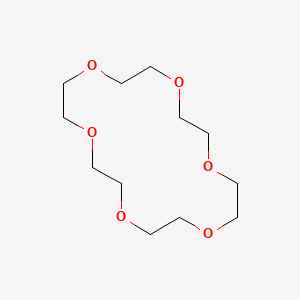


1. 18-crown-6
1. 18-crown-6
2. 17455-13-9
3. 18-crown-6 Ether
4. Ethylene Oxide Cyclic Hexamer
5. 18-crown-6-ether
6. 18-crown 6-ether
7. Mfcd00005113
8. Hexaoxacyclooctadecane
9. 18-crown6
10. Chebi:32397
11. 1,4,7,10,13,16-hexaoxacyclooctadecane (18-crown-6)
12. Chembl155204
13. 63j177nc5b
14. Nsc-159836
15. 1,4,7,10,13,16hexaoxa-cyclooctadecane
16. Ccris 3587
17. Einecs 241-473-5
18. Nsc 159836
19. Brn 1619616
20. Unii-63j177nc5b
21. 1,4,7,10,13,16-hexanoxacyclooctadecane
22. 18-crown-6ether
23. O4b
24. 18crown-6
25. 18-crown 6
26. 18--crown-6 Ether
27. [18]crown-6
28. 18 -crown-6
29. 18-crown -6
30. Crown Ether 18-crown-6
31. Schembl1119
32. 18-crown Ether-6
33. 5-19-12-00601 (beilstein Handbook Reference)
34. 18-crown-6, 99%
35. Dtxsid7058626
36. 18-crown-6, Pkg Of 25 G
37. Act02792
38. Amy25595
39. Bcp24491
40. Cs-d1202
41. Zinc3861356
42. 18-crown-6 Ether, 97+ Percent
43. Bdbm50530238
44. Nsc159836
45. Stl185678
46. 18-crown-6, >=99.0%
47. Akos000268988
48. 1,7,10,13,16-hexaoxacyclooctadecane
49. 1,7,10,13,16-hexanoxacyclooctadecane
50. 18-crown-6 Solution, 1.0 M In Thf
51. Wln: T-18-o Do Go Jo Mo Potj
52. 1,4,7,1,13,16-hexaoxacyclooctadecane
53. 1,4,7,10,13,16-hexaoxacyclooctadecan
54. 3,6,9,12,15,18-hexaoxacyclooctadecan
55. Ac-29207
56. Bp-10155
57. Sy002250
58. 1,4,7,10,13,16-hexoxacyclooctadecane
59. 1,4,7, 10,13,16-hexaoxacyclooctadecane
60. 1,4,7,10,13,16-hexaoxacyclo-octadecane
61. 1,4,7,10,13,16-hexaoxacycloocta-decane
62. 18-crown-6, Purum, >=99.0% (gc)
63. Ft-0607264
64. En300-17608
65. 18-c-6
66. 455c139
67. A811662
68. Q-200102
69. Q3238432
70. 18-crown-6, For Ion Chromatography, >=99.0% (gc)
71. F0001-0636
72. 1,4,7,10,13,16-hexaoxacyclooctadecane;1,4,7,10,13,16-hexaoxacyclooctadecane (18-crown-6)
| Molecular Weight | 264.31 g/mol |
|---|---|
| Molecular Formula | C12H24O6 |
| XLogP3 | -0.7 |
| Hydrogen Bond Donor Count | 0 |
| Hydrogen Bond Acceptor Count | 6 |
| Rotatable Bond Count | 0 |
| Exact Mass | 264.15728848 g/mol |
| Monoisotopic Mass | 264.15728848 g/mol |
| Topological Polar Surface Area | 55.4 Ų |
| Heavy Atom Count | 18 |
| Formal Charge | 0 |
| Complexity | 108 |
| Isotope Atom Count | 0 |
| Defined Atom Stereocenter Count | 0 |
| Undefined Atom Stereocenter Count | 0 |
| Defined Bond Stereocenter Count | 0 |
| Undefined Bond Stereocenter Count | 0 |
| Covalently Bonded Unit Count | 1 |
BUILDING BLOCK

